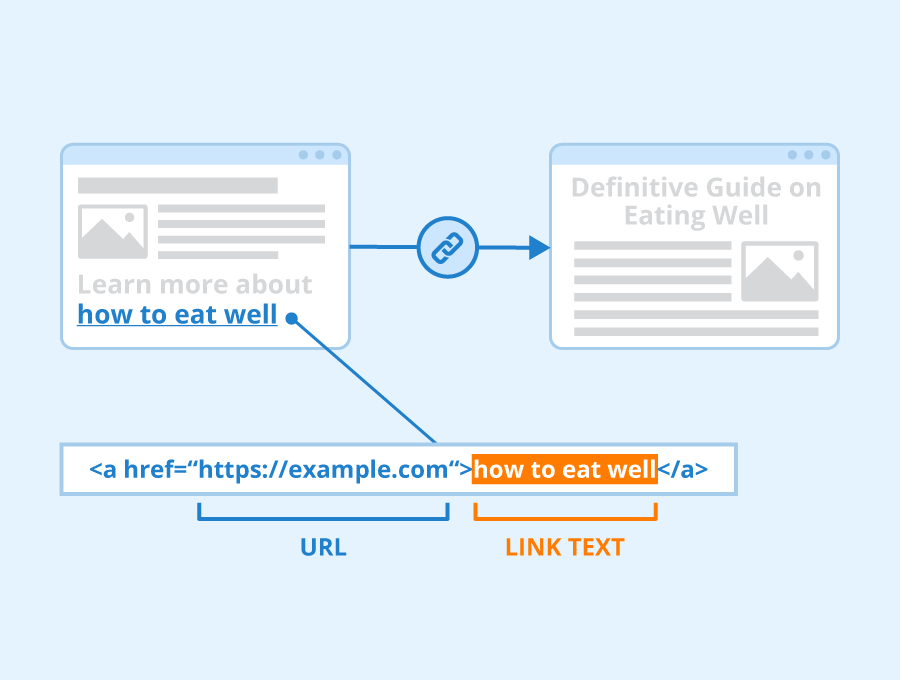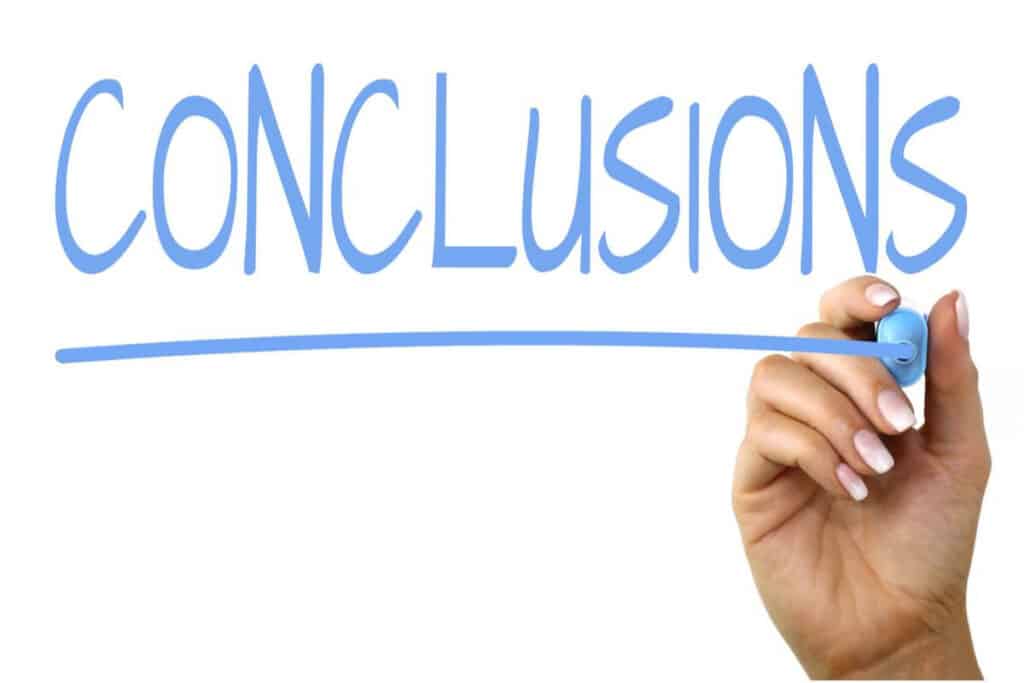
Well, that’s just how my brain works. But then I realized that it is something like this –
I don’t know what you thought, but if you were as clueless as me about this expression as I was before I learnt about it, tell me, does this ring a bell?
If it does, then you have used anchor text in a way without knowing it is called that.
When it comes to SEO for your website, more is less. What works today may not work tomorrow. It is not enough that you produce high-quality content, but you also need to use different aids and follow best practices to make this content eligible to rank in search results You need to make sure you have covered all the bases.
SEO pros are big on link-building. And while we are talking bigness, the terms you use to link in and out of your pages also matter – BIG TIME! These terms are called anchor text.
I suggest you continue reading this article to know what is anchor text and why is it important in SEO.
Anchor text meaning
Anchor texts are those colored (usually blue), clickable, links you see on websites that take you to other pages. The words are anchoring one page to another.
The target pages usually contain relevant information related to the main content topic. Anchor texts give context to both your users and search engines to know what is coming after clicking on them.
Why are anchor texts important in SEO?
The advantage is two-fold.
1) The text informs users what they are going to find on clicking on them.
Anchor text provides context to users too and they know what they will find by clicking on that text. When the user wishes to understand what these keywords mean and you provide them the link explaining what they are, they are going to stay on your website, and get all the information they need so they can leave satisfied.
Relevancy here is crucial, because of this linked content is not relevant to the topic in question, it amounts to a bad user experience. You need to ensure that these links add value to your content.
2) The text informs search engines of keywords and their context
The advantage with search engines is that they can use the anchor text to identify the theme or context, and determine the keywords/queries it should rank for. It plays a crucial role in link-building strategy and has an impact on the organic search volume and performance of a website.
Anchor texts can be used to describe links more specifically than their metadata. Using the right keywords in the anchor text influences the rankings of those keywords by telling Google which page should be ranked for that particular keyword and distribute link authority from one page to another.
Mindful use of keywords in anchor texts not only helps build your readers’ trust in your brand and content, but also boosts your SEO strategy by giving directed signals to search engines.
Now that you know they are important you need to know how to optimize anchor text in SEO. But before you do that, it is best that you learn the different types of anchor text so you that you can imagine what works best for you when you can use them.
Types of Anchor text with examples
Generic
Anchor text that uses general expressions to link to other pages are generic anchor words. The text does not usually provide context by themselves but the user may imply it from the surrounding content. They are open-ended and serve as call-to-action text.
For example:
- Click here
- Read more
- This page
- More info
- Download
Exact match
Exact match anchor text uses the exact keywords that the page you are linking to is targeting. And that’s why this is the most important type of anchor text you can be using to improve your ranking.
For example, if someone uses the words “anchor text” as anchor text and links to this article, then it would be an exact match link text.
Other examples, assuming that the links would take to the exact page relating to the phrases:
- Running shoes
- Used books
- Digital marketing agencies in Bangalore
- Free SEO tools
Branded
Branded anchor text includes brand names and helps establish brand recognition. If there are prominent people, influencers, journalists, authors, or any important names involved with your brand, you can use them too as brand anchors.
You need to ensure that the usage is not forced and that you are not simply overstuffing them. Also, try not to get sued by using other brand names when you are not supposed to.
Some examples are:
- Rankmath
- Ahrefs
- Semrush
LSI Keywords
All users may not use the exact same words to search for the same query. LSI means latent semantic indexing which means words that are variations or synonyms which our brains see as same, but search engines don’t!
You can find these by typing out your target keyword in the search and look the suggestions that Google offers.
They can also include related queries that are commonly searched for those target keywords.
You can use these variations in your anchor texts instead of using the same words repeatedly in the same piece of content. For example:
- Digital marketing agency can be a variation of digital marketing company
- Online store and online shop
- Anchor text or link text
Partial Match
Partial match anchor words are kind of like the LSI keywords but containing only a part of the keywords. You are in fact using the keywords with other generic phrases.
For example:
- Anchor text is your target keyword you may use words like. Know all about anchor text.
- Breadcrumbs – read why breadcrumbs are important
Related
Related anchor text is like the partial match anchor text without using specific keywords. They are used that way to avoid spamming and add diversity to your anchor texts.
For example:
- On-page SEO when your target is How to use Rank Math
- Learn about blogging – How to start a blog
Random
This can be and LSI keyword for generic anchor text, but I would say it is a sort of in-between to generic and specific. You are not simply saying click here nor are you using the keywords. But you are using words like
- Learn more about
- In dept article
- For further reading
Naked Anchor text
This is a no-brainer but not really the most effective usage nor very helpful. Naked anchor texts are where you use the URL raw as it is!
For example:
Article or Page title
You are using the title of the article you are linking out to. The anchor text makes it obvious what the link is all about, but obviously, you cannot use them with the flow of your content. You can simply list out the topics related to the content for your readers for some additional reading.
Examples:
Image
Google reads the alt text of the images as anchor text. This approach is usually used with images that are clickable with call-to-action – Buy now, Book now, Apply now, Register now.
Just make sure the users can know they are clickable and it takes them someplace relevant.
Long-tail
Long-tailed anchor words are longer variations of your target keywords. It is like the partial match anchor text but allows you to be more descriptive. It can be a long sentence or an entire heading or sub-heading. But it cannot be used a lot and all the time.
Examples:
- Learn how I ranked 2400 keywords with zero backlinks.
- Read how to use breadcrumbs effectively for SEO.
Variations and combinations
This is not an explicit type of anchor text but just me suggesting to you that you can also use a combination of different types of anchor text. A combination at once, or as a distribution across the entire content.
For example:
Branded anchor text + Keyword
Generic anchor text + Keyword
Naked anchor text + Keyword
How to add anchor text on WordPress?

Before you tense your brain muscles, let me tell you, I only suggest no-code methods. WordPress editor offers you the option to anchor your text in its text editor and you can apply it in a matter of few seconds.
1) Write your content.
2) Select the content you want to add the link to. You may see a box as below hovering around your text. (Ctrl+k works too)
3) Click on the link-like symbol I have underlined in blue and a text box drops down where you can paste your target page URL.
4) After you paste the URL you can enable the toggles below as you need.
5) Press enter to add the link or click on the Submit arrow.
How to optimize anchor text in SEO? – Dos and Don’ts
As I said in the beginning, following best practices for SEO is necessary for your SEO strategy.
It is not enough that you use these tools, but you need to use them right and avoid ticking Google off (you cannot emotionally tick off Google, but Google can penalize you).
Here are some ways you can stay within the lines.
Stick to your topic, maintain relevancy
If you are writing on a specific topic, then make sure your link texts are all targeting topics related to the source topic. Since Google would be ranking for those target keywords, you would want to provide answers to user queries. Keep in mind the search intent of users
Make it natural with the surrounding text
Writing must flow naturally, and so should your link texts along with your content. Try not to force and anchor text where it has no right to be.
Link text should match the target page
If your anchor text says SEO tools, then clicking on it should take your user to a page with SEO tools and not Indian silk sarees or how to reduce tummy fat. If you are misleading your users, it is bad practice.
Incorporate and distribute variations
Avoid using too many exact or generic anchor texts. Too many exact links are seen as spam by Google and generic links are pointless. Diversify different types of anchor texts and blend them with your content easily.
Don’t stuff keyword density
Keep the keywords low-key. You don’t want to be penalized for overstuffing and also it leads to poor user experience.
The link should be distinguishable
Let your user know that the text is a clickable link using different text color than the surrounding text, and/or underlining them. I recommend you do both.
Include guest posts
If you are into build a strong link profile, writing guest posts for high-authority domains can be very effective. You can use LSI anchors and partial match anchors (without keyword stuffing and over-optimizing, of course) for these posts.
Try to make write posts within your niche so you can co-cite them and add value.
Learn a little about backlinks
Don’t buy backlinks, because that would be messing with Google guidelines again. But you can monitor them and see how you can optimize them for better results.
Don’t forget alt text in images
Don’t leave alt text black, but don’t stuff keywords there either. You can reasonably describe the image for alt texts do have a purpose in life.
- Helps describe the image for the visually impaired.
- Tells Google bots what the image is about
- Can be used as anchor text.
Choose a relevant keyword and convey in simple words what the image is about.
Here’s a bonus tip to round off the numbers
Maintain an inventory of your anchors and links which will come in handy when you are kneading on your optimization dough and also when you want to do site audits.
Bottom line

That was all I could tell you about anchor text. Your core SEO objective is always to improve user experience and anchor texts can do that for you. It would not harm you if in that process you are also impressing Google a little so you can rank.
Google is getting smarter to know when you are playing underhand games. I believe, being mindful of the words you use and how you use them, and including diversity while confining to moderation is not just about personality development but necessary for SEO development too!
What do you think about Anchor texts?
Drop your comments and let me know!


